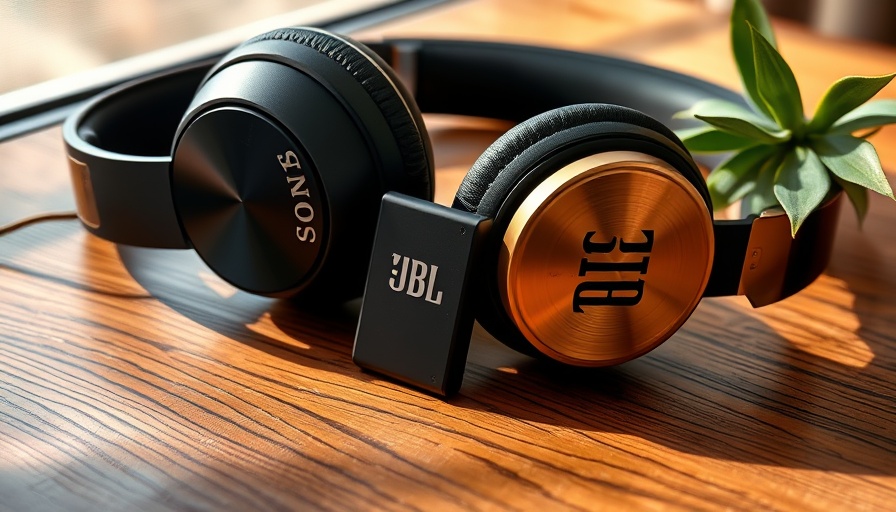
Setting the Stage: The Rise of Premium Noise-Canceling Headphones
In a world increasingly buzzing with noise, the demand for premium noise-canceling headphones has soared. Consumers seek not only superior sound quality but also advanced features that enhance usability and flexibility. Sony and JBL are two corporations at the forefront of this evolving landscape, each presenting unique offerings tailored to users' preferences. Enter the Sony WH-1000XM6 and the JBL Tour One M3 — both contenders that benchmark what flagship ANC models should embody.
Comparative Analysis: Sony WH-1000XM6 vs. JBL Tour One M3
At first glance, both headphones bring significant strengths to the table, yet their approaches differ. The Sony WH-1000XM6, priced at $449.99, continues Sony's legacy of excellence in ANC technology. It features impressive sound quality and device compatibility, making it appealing for audiophiles. However, users might find the absence of USB listening and ingress protection disappointing, given its high price point.
On the other hand, the JBL Tour One M3, competitively priced at $399.95, embraces cutting-edge innovations. The flagship headphones boast lossless audio over USB, an enticing feature for those who crave uncompromised audio fidelity. Moreover, the inclusion of the SMART Tx transmitter adds a layer of versatility that allows audio sharing with various devices, though it may require some users to tinker for optimal audio performance.
Contextualizing Features: What Sets Them Apart
Distinguishing factors beyond just technical specifications often determine the buyer's decision. For instance, comfort is paramount for users planning extended wear—something both brands consider. The Sony WH-1000XM6, while not adjustable, promises a snug fit with high-quality materials designed for long listening sessions. Meanwhile, the JBL Tour One M3 offers plush pads and a fold-flat design that's travel-friendly, though those with smaller head sizes might find the fit less secure.
The contrast continues with their controls. The Sony model favors intuitive physical buttons, allowing easy access without fumbling, while the JBL opts for a response-heavy touch control system that may take some adjustment.
Emotional Appeal: Choosing Based on User Experience
The emotional connection consumers develop with products often influences purchasing decisions. The Sony WH-1000XM6 is often regarded as a reliable choice for those who value tried-and-true designs complemented by minor upgrades. Users find comfort in the familiarity and strong reputation of Sony's noise cancellation technology.
Conversely, JBL's Tour One M3 offers a fresh perspective, appealing to tech-savvy individuals unafraid to explore the latest features. The excitement over advanced functionalities and design choices creates an allure that cannot be ignored. This differentiation calls to those who wish to stay ahead in the technology curve, possibly swaying users looking for an investment in the future of sound.
Future Insights: Evolution of Noise-Canceling Technology
The trajectory of noise-canceling headphones suggests that advancements like lossless audio and improved usability will not just become standard; they may redefine the marketplace entirely. As leading companies like Sony and JBL continue competing, consumers can expect ongoing innovation that addresses both sound quality and seamless connectivity across devices.
Furthermore, as brands integrate features like multipoint Bluetooth connectivity and enhanced voice assistant capabilities, the user experience will become richer and more dynamic, affirming the notion that the future of audio might very well lie in personalized sound.
Making the Choice: Which One is Right for You?
In searching for the ideal headphones, it's crucial to assess your priorities. Whether valuing sound quality, advanced features, or comfort, weighing these factors against the distinct advantages each model offers will guide your final decision. Will you lean into tradition with Sony, or embrace innovation with JBL? In the end, both options promise a powerful auditory experience designed to drown out the noise of the modern world.
As you weigh your options, consider what aspects of functionality resonate most with your day-to-day routine. Each model enhances life’s sonic moments—so choose wisely to suit your lifestyle and personal soundscape.
 Add Row
Add Row  Add
Add 




Write A Comment